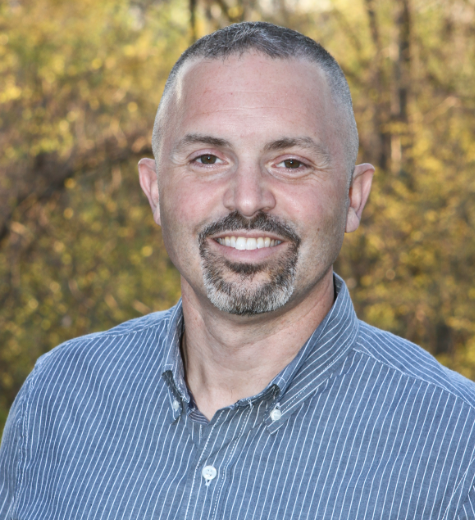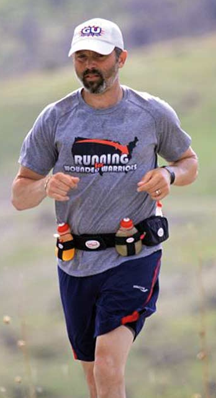 There are runners, and then there are runners who push the known limits of human endurance. My friend and fellow West Virginian Jamie Summerlin is one of these amazing athletes.
There are runners, and then there are runners who push the known limits of human endurance. My friend and fellow West Virginian Jamie Summerlin is one of these amazing athletes.
Jamie Summerlin is a Gulf War-era veteran, having served in the United States Marine Corps for six years. Currently, the Marine veteran serves as the President of the Board of Directors of Operation Welcome Home in Morgantown, West Virginia, and is involved in other veteran-focused programs, such as CamoToCap. He is also an inspirational speaker for business and professional organizations, schools, veteran groups and the running community.
In 2012, Jamie embarked on his own Freedom Run– a 3,452-mile, 100-day ultrarunning endeavor that began in Coos Bay, Oregon, and ended in Rehoboth Beach, Delaware. He covered a whole lot of ground, a total of 16 states and the District of Columbia, with the final 100 miles being completed in just less than 24 hours. He became the 48th person to complete a true coast-to-coast transcontinental run across America.
Jamie’s journey not only raised money for national and local organizations whose mission is to assist veterans, but it inspired communities and veterans alike to dream big and find ways to support the United States military and veterans.
 As a fellow military member, when I first heard of Jamie’s transcontinental mission, I wanted to support him any way I could. I had rode my bike across the U.S. over 20 years ago, but running that entire distance? That is a far more difficult challenge. My store, Two Rivers Treads, provided Jamie with 10 pairs of Saucony shoes. We followed his progress, and we welcomed him as he passed though town, sharing a group run and a large meal for refueling.
As a fellow military member, when I first heard of Jamie’s transcontinental mission, I wanted to support him any way I could. I had rode my bike across the U.S. over 20 years ago, but running that entire distance? That is a far more difficult challenge. My store, Two Rivers Treads, provided Jamie with 10 pairs of Saucony shoes. We followed his progress, and we welcomed him as he passed though town, sharing a group run and a large meal for refueling.
Jamie recently returned to Shepherdstown, WV and spoke at the Freedom’s Run pasta dinner. He also signed copies of his book (you can buy it on Amazon.com). His memoir is truly inspirational.
Here’s an interview I had with Jamie not too long ago:
Q: How did you prepare for this trip?
Jamie:I spent almost 21 months from the plan inception to stepping off by putting more miles on my feet than at any point in my life, running 2,750 miles during all of 2011 to physically get ready. I also ran numerous ultramarathons, including a 77-mile and 100-mile race within 7 weeks of each other. During the months of September to November of that year, I got up at 3am, started running at 3:30am, ran 16 miles, stopped by my house to grab food and drinks, then run the 7 miles to work. I would work all day, then run 7 miles home, not only physically preparing, but mentally preparing as well. I knew if I could get through that, all I would need to do when the run commenced was eat, sleep, and run…not worrying about all the other stresses of maintaining day-to-day life.
Q:Did you do any research or work on your running form?
Jamie: Having run my first marathon in November of 2009, I was still a newbie as far as distance running was concerned. I read numerous books and spoke with many seasoned ultra-runners to absorb as much as I possibly could prior to the run. Marshall Ulrich’s book “Running on Empty” helped tremendously, as I experienced a lot of the same issues he faced, and was prepared to deal with them when they occurred. I also spoke to running coaches about my form and was fortunate that I have a very neutral stride and foot arch, so all I really needed to learn was how to become more efficient.
Q:Did you have any injuries during the trip?
Jamie:I developed severe shin splints on day 5 with my left leg, because I climbed from 1000 feet in elevation at Steamboat Inn, Oregon, to over 5,300 feet in elevation at Diamond Lake, all in the last 25 miles of my 39 mile run that day. My shin became swollen for the next few days, which caused me to have to speed walk and not extend my ankle out much if at all. Four days later, to get over it, I lied down in the back of the RV while my wife stretched out my ankle and ran her hand down my shin, causing the adhesions to sound like Rice Krispies when they broke apart. Over the next 48 hours everything returned to normal and I ran the rest of the way. About 2,500 miles into the run, I started wearing a knee compression sleeve on my right knee to help alleviate some IT band pressure I was feeling, which seemed like a natural occurrence after 2,500 miles of pavement.
 Q: How did you deal with these physical issues while running 30 miles a day?
Q: How did you deal with these physical issues while running 30 miles a day?
Jamie: During the shin issue, I moved to the other side of the road to take some pressure off my left leg, used walking sticks, and at one point shoved snow into the front of my cold weather pants to try to numb the pain. My 6-7 hour days quickly went to 12- and 13- hour days, as I was dealing with not only the pain, but snow that restricted my view and couldn’t see past quarter mile in front of me, with snow drifts taller than our RV.
Q: Did you feel like you got stronger as the trip went on?
Jamie: About 30 days into the run, I woke up in the morning and felt like I hadn’t ran the day before. As I crossed the country, my running times continued to speed up, which caused me to average a 10-minute pace for the entire trip. Running across the Appalachians, those that would join me would remark at how crazy it was that I could run up the mountains and carry on a conversation like I was sitting still.
Q: What was the most challenging part of the run?
Jamie: While the beginning brought on its own challenges of adjusting to the miles, and the Rockies put me to elevations I hadn’t ran at before, the Appalachians proved to be the toughest all around on my body, as the inclines and declines on the roads came rapidly, and varied from 8% to 13% grade, causing my legs to feel stress I didn’t feel at any other point of the journey.
Q: What were some of the most important lessons learned that would help any runner, beginner or experienced?
Jamie: “Listen to your body”. One of the things that helped me prepare for this was to listen to my body when I was feeling pains that weren’t normal running pains (foot pain, knee, etc) as I increased the mileage, and took the necessary time off to heal up. Obviously, when I did the run, my stubbornness and training helped me push through the pains that came, but while training I didn’t push through injuries that would end up taking me out for long periods of time. It is a practice I still follow.
Q: Talk a little about food. Any specific things you found help keep you energized or better in recovery?
Jamie: I spoke with registered dieticians and read a lot before I left on my run, and we planned to prepare meals that would work for a few days, but realized once we started that most of our plans we just had to throw out the window. I settled on a diet that worked out for me, and even though I continued to eat the same foods, I didn’t get bored with them because they worked for me. At one point my wife tried to change it up on me, changing up the normal foods I was eating to try other things, and also because she was tired of fixing the same thing all the time. Within 48 hours I returned to my normal routine of starting off each morning with chocolate fudge Pop Tarts, and each stop was filled with a plate full of food. From bananas smothered in nutella and rolls covered in butter, to sandwiches with sliced turkey and chicken and fruit, to Greek yogurt and more sandwiches, and lots of watermelon. Watermelon is one of my favorite ultra-running foods, and I ended up eating 25 watermelons in total during the run. I didn’t drink a sip of water during the run, instead consuming 2-3 gallons of orange Gatorade each day. I was taking in 8-10,000 calories a day, burning 5-7,000 just during my run times, and of course my body was still burning through calories when I wasn’t running, causing me to lose 17 pounds during the entirety of the run. On the final day, I drank 9 gallons of Gatorade and ate an entire watermelon, plus all of my other foods, as it was over 100 degrees running on freshly blacktopped road as I completed the final 100 miles in just under 24 hours.
Q: Your future goals?
Jamie: I want to run a 100-mile ultra marathon on every continent (Antarctica only has a marathon that I’m aware of, so I’ll have to make do with that), and I know of another runner who wants to run a marathon in every country in a year. Since I ran the equivalent of 132 marathons in 100 days, I look at it as it’s only another 100 marathons over a 365-day period. What’s so hard about that? Other than finding the sponsor to make it happen. Physically I have no doubt I can do it.
Q: Any larger message for the State of West Virginia, and others?
Jamie: My ultimate purpose was to raise awareness and honor our military heroes, but I also had a secondary purpose, to shine a positive light on the state of West Virginia. I did a lot of education of people out West who didn’t realize Richmond is not in our state, and I’ve also met so many people who started running here at home because of following my journey. A healthier West Virginia is what I want for my home state and having so many young and old alike joining me on the run through my state filled me with a lot of pride. Our state rankings are horrible when it comes to physical fitness levels and disease epidemiology, and I want to be a part of helping us improve our fitness levels and the future of our healthy lifestyles in West Virginia.
***
Excerpt from Jamie’s memoir, Freedom Run, and which can be purchased here.

